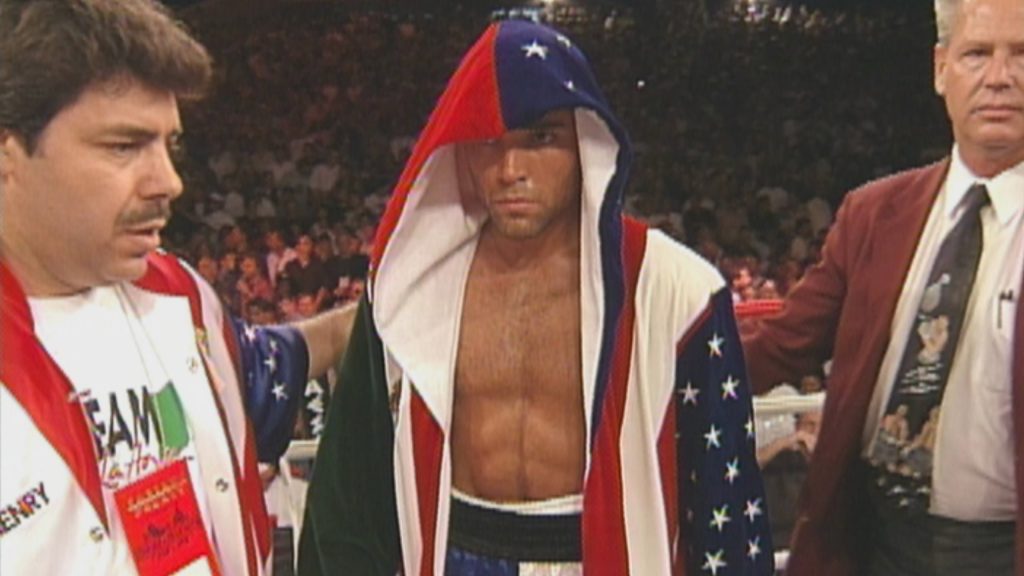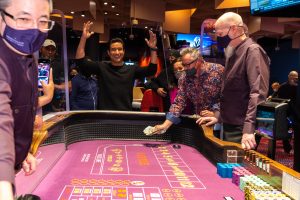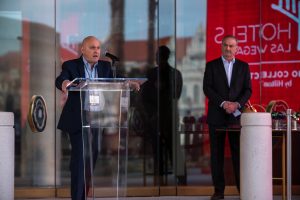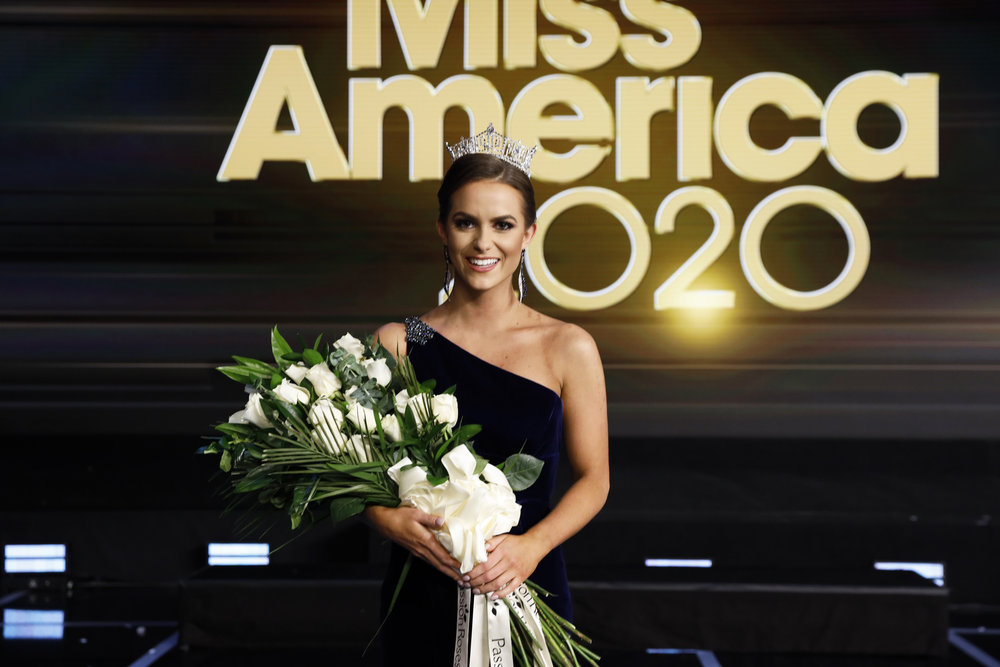January 23, 2022
by Carla Hay

“La Guerra Civil”
Directed by Eva Longoria Bastón
Some language in Spanish with subtitles
Culture Representation: Taking place in primarily in the United States and Mexico, the documentary film “La Guerra Civil” features a predominantly Latino group of people (with some white people) discussing the rivalry and careers of world champion boxers Julio César Chávez and Oscar De La Hoya.
Culture Clash: Chávez and De La Hoya, who faced off in two championship matches in 1996 and 1998, represented two aspects of Mexican-rooted culture (native Mexicans for Chávez, Mexican Americans for De La Hoya), which affected the type of fan support and images that each boxer had.
Culture Audience: “La Guerra Civil” will appeal mainly to people who are interested in movies about boxing and how ethnicity plays a role in athletes’ identities and public perceptions.

“La Guerra Civil” goes beyond the usual clichés of boxing documentaries, by taking a candid look at how Julio César Chávez’s Mexican identity and Oscar De La Hoya’s Mexican American identity shaped their championship careers. It’s a traditionally made documentary that doesn’t really break any new ground in cinematic techniques, but the content of the story is meaningful because it shines a light on how ethnicity and nationality have a massive effect on how people feel about a public figure. The movie also vividly describes the conflicts (both internal and external) that can arise when someone identifies as a member of two different countries. Chávez and De La Hoya both participated in “La Guerra Civil,” which had its world premiere at the 2022 Sundance Film Festival.
“La Guerra Civil” (which means “The Civil War” in Spanish) is the feature-film directorial debut of Eva Longoria Bastón, a Mexican American who is an ideal person to tell this story because she’s lived many of the experiences described in the documentary. There is an authenticity to how this story is told that cannot be replicated by a documentary director who can’t relate to the main subjects of the film. “La Guerra Civil” is not told in complete chronological order, but the engaging editing makes the storytelling easy to follow.
Longoria Bastón conducted the main interviews (she can sometimes be heard off-camera asking follow-up questions), and she made the wise decision not to overstuff the movie with too many talking heads. Because much of the archival footage consists of boxing matches that were already televised, there aren’t many surprises in what’s shown in the documentary, except for some childhood photos or videos of Chávez and De La Hoya. The real value in “La Guerra Civil” is how these two former champs open up about how their past rivalry was bigger than a boxing title: It was a reflection of how people of Latino (especially Mexican) heritage felt about themselves.
“La Guerra Civil” dutifully covers a lot of biography basics that fans of Chávez and De La Hoya might already know but people unfamiliar with boxing might not know. Born in 1962, Chávez grew up very poor in his hometown of Ciudad Obregón, Sonora, Mexico. He had four brothers and five sisters; their father was a railroad worker.
In the documentary, Chávez reveals boxing wasn’t even his favorite sport as a child. He says that at the time, “I liked to play soccer, baseball and volleyball. I liked everything except boxing, because I had two brothers who started boxing before me. ” He adds, “I never thought I’d become a world champion.”
Chávez remembers one of his motivations to start boxing was after he got beaten up by a girl when he was an adolescent. At 16 years old, Chávez eventually got interested in boxing as a way to make money for the family, but he initially had to keep his training a secret from his mother, who disapproved of another one of her sons getting into boxing.
Chávez’s mother, whom he describes as kind and nurturing, eventually approved of his boxing activities when she and the rest of the family saw how talented he was and how his boxing earnings could benefit the family. He relocated from Culiacán to Tijuana to train as a professional boxer. (Hall of Fame boxing trainer Ignacio Beristán gives some background on how Tijuana is an important training ground for Mexican boxers.) Chávez’s “rags to riches” story made him a boxing hero to many, especially those coming from disenfranchised and underprivileged backgrounds.
By contrast, De La Hoya came from a family of boxers (his father, grandfather and brother), and he was pushed into boxing from an early age by his father. “I was forced into it,” De La Hoya says in the documentary. De La Hoya began competing in amateur boxing matches when he was 6 years old. This self-described “scrawny kid” would often bring down opponents who were a lot more muscular and more experienced than he was.
Born in Los Angeles in 1973, De La Hoya is the son of Mexican immigrants, whom De La Hoya says made their household more of a Mexican household than an American household. But because he was a first-generation American, De La Hoya was able to experience and represent both Mexican and American cultures, including being fluent in Spanish and English. Although Chávez and De La Hoya both say that they grew up in rough neighborhoods, De La Hoya’s East Los Angeles neighborhood was decidedly more middle-class than Chávez’s destitute La Redonda neighborhood in Culiacán.
De La Hoya says his first memory of boxing was the boxing fights that would take place for fun in the garage of his uncle. When De La Hoya was about 5 years old, he was ordered to fight one of his older cousins. De La Hoya vividly recalls the fear and humiliation he felt when he lost the fight and how it motivated him to beat the cousin in a rematch.
Golden Boy Promotions president Eric Gómez, who’s been a friend of De La Hoya’s since their childhood, remembers that De La Hoya’s childhood revolved around boxing: “He [could] play for a little while, but when his dad would come out of work, it was time for [Oscar] to go to the gym.” Sports journalist Ron Borges compares De La Hoya to Tiger Woods, in how both athletes had hard-driving fathers who gave them no choice but to train in their respective sports at an age when most children are in kindergarten. “Little Oscar was a business commodity for his father,” Borges comments.
De La Hoya describes these early experiences in terms of how they influenced his career and how he approached boxing. He says that his boxing career was often about him feeling underestimated and wanting to prove his skeptics wrong. Although De La Hoya reached the heights of professional boxing, he makes it clear that it was with constant criticism from many people who thought that he “wasn’t Mexican enough.”
His good looks and the media’s “The Golden Boy” nickname of De La Hoya also made him the target of ridicule by people who thought he was too handsome and too Hollywood to be taken seriously. It’s mentioned several times in “La Guerra Civil” that at public appearances, De La Hoya would get just as many cheers and he would get boos from audiences.
Several of the people interviewed in the documentary discuss at length why Chávez got such unwavering public adoration in Mexican communities, while reactions to De La Hoya were decidedly more mixed. Boxing commentator Eduardo Lamazón says, “Chávez was a man of the people, of the slums. He was raised like many Mexicans, eating the same food as they did, listening to the same music. And he boxed like a Mexican too.” Boxing journalist Jose Luis Camarillo adds, “Chávez was a god. He was the star of the show.”
Sports reporter Claudio Trejos describes a common perception: “For the die-hard boxing fan, Oscar’s just a pretty boy from East Los Angeles. He’s not a real Mexican.” It’s also mentioned in the documentary that people would often call De La Hoya a “pocho,” which is a derogatory term for a person of Mexican heritage who is deliberately ignorant of Mexican culture and doesn’t know how to speak Spanish. It’s a word that bilingual De La Hoya was unfairly applied to him because he says he was raised in Mexican culture and can fluently speak Spanish and English.
On the plus side for De La Hoya was his crossover appeal, which was skillfully marketed by people such as boxing promoter Bob Arum, who helped get De La Hoya many lucrative endorsement deals. By contrast, Chávez fluency in English remained very limited. In the documentary, sports agent Leigh Stenberg says about De La Hoya: “He radiated charisma. He had a killer smile. If you had to create a marketable boxer, you couldn’t go wrong with starting with Oscar De La Hoya.”
Sports journalist Dan Rafael comments, Chávez made himself a legend … He was the star of stars until Oscar De La Hoya came along.” Gómez comments on when the real backlash started against De La Hoya: “It wasn’t until the [1996] Chávez that people started questioning, that people started saying, ‘He’s [De La Hoya] is not a real Mexican.”
“La Guerra Civil” talks about the rise and fall of these two boxing champs, with a lot of emphasis on the rise. The expected highlights of their careers are shown in clips of thrilling boxing matches, as well as large, adoring crowds who gathered to see them at other public appearances. There’s enough discussion of boxing techniques to please boxing fans but not too much of an overload that would alienate people who aren’t boxing enthusiasts.
De La Hoya talks a lot about his commitment to rigorous training, which served him well when he went up against his hero Chávez for the first time, in 1996 for the World Boxing Council’s light welterweight championship. It was billed as the Ultimate Flory fight. In the lead-up this famous boxing match, Chávez and De La Hoya (and their respective entourages) did a U.S. press tour. While De La Hoya was keeping a tight schedule of an athlete in intense training, Chávez was spending his free time doing a lot of partying.
Borges, who covered the press tour, remembers the contrasting lifestyles of Chávez and De La Hoya on this tour: “He [De La Hoya] was working out every day. Chávez was, I assure you, not working out during this trip. He was out [partying], but he was not working out.”
De La Hoya shares his perspective of his and Chávez’s very different approaches to preparing for this big fight: “He’s not taking me serious. But guess what? I’m going to take you serious.” Chávez essentially admits that all of this was true.
When Chávez and De La Hoya had their rematch in 1998, De La Hoya said he didn’t slack off on his intense training. De La Hoya convinced legendary boxing Jesús Rivero (who’s interviewed in the documentary) to come out of retirement to help with De La Hoya’s training. De La Hoya describes Rivero as “a man of few words” and “grumpy” but “by fair the best trainer I ever had.”
Based on how De La Hoya and Chávez discuss how fame affected them, Chávez might have been more beloved overall by people of Mexican heritage, but Chávez had more self-esteem problems in coping with his success. Chávez says that although he got everything he ever dreamed of in his career and he was surrounded by people who adored him, at the height of his fame, “I felt very alone.”
Feeling lonely and empty inside is why Chávez says he turned to cocaine for comfort. He mentions that the first time tried cocaine was after winning a light welterweight title fight against Héctor “Macho” Camacho in 1992. “And that was my ruin,” Chávez says of cocaine. “I took refuge in drugs and alcohol.”
Chávez is open about his addictions to drugs and alcohol, but De La Hoya doesn’t discuss in the documentary that he also had addictions to drugs and alcohol. De La Hoya’s personal demons and rehab stints are briefly mentioned by someone else toward the end of the documentary, almost as if it’s an afterthought. You get the feeling that De La Hoya wanted this topic to be off-limits in order for him to participate in the movie.
The documentary also leaves out any talk about other aspects of Chávez’s and De La Hoya’s personal lives. For example, their marriages and children are not discussed. The movie makes passing references to De La Hoya being a sex-symbol boxer to many women when he was in his prime, but he doesn’t go into details about how he handled all that amorous attention.
Even though De La Hoya doesn’t talk about his addictions in this documentary, he does show a vulnerable side when remembering about his late mother Cecilia and his complicated relationship with her. Oscar De La Hoya’s brother Joel De La Hoya Jr. describes their mother Cecilia as Oscar’s biggest fan. Oscar says, “My mother went through a lot of emotional abuse,” but “she beat the hell out of us … My aggression, my pain, my anger—that comes from her.”
Oscar also shares his heartbreak of his mother dying of breast cancer in 1990, just three weeks after he won the gold medal at the Goodwill Games. “It was the biggest blow I ever felt in my life,” he says of his mother’s death. Oscar says he became so depressed that he was going to quit boxing, but he changed his mind, largely because he had promised his mother that he’d win a gold medal in boxing at the 1992 Olympics. And he did. When De La Hoya famously waved the flags for Mexico and the U.S. after his Olympics victory, this symbolic act of identifying with both nations cemented his dual heritage in many people’s minds.
The 1996 boxing match between Chávez and Oscar De La Hoya marked the first time that a Mexican and a Mexican American would be battling each other in this type of high-profile boxing championship. Critical sports scholar Rudy Mondragón explains why this particular match had such cultural resonance, particularly with people of Mexican heritage: “Boxing is a sport that’s never been shy to utilize race and ethnicity to create a theatrical spectacle … It was like the world was telling us: ‘There’s one way to be Mexican: Oscar’s way or Julio’s way.”
In the documentary, actor/comedian George Lopez and actor/TV host Mario Lopez, who are both Mexican American and not related to each other, share their thoughts on the Chávez/De La Hoya rivalry. Mario Lopez says he’s been a die-hard fan of Chávez since childhood, while George Lopez seems to be more sympathetic to De La Hoya. George Lopez and Mario Lopez are the only two people interviewed in “La Guerra Civil” who aren’t in the boxing/sports industry, but their “fan perspective” still seems very privileged since they’re both celebrities.
Some people might find “La Guerra Civil” lacking in some areas. For example, Trejos is the only woman who’s interviewed. This token female perspective is very noticeable, especially since the documentary mentions several times that women were a large percentage of Oscar De La Hoya’s fan base.
The movie also leaves out the perspectives of any professional boxers who had high-profile matches against Oscar De La Hoya or Chávez. Commentaries from “non-celebrity” boxing fans are only in very brief clips from archival news footage, not in new interviews conducted for the documentary. The only family member of Chávez who’s interviewed is his brother Rodolfo, who makes a brief appearance in the movie.
Although “La Guerra Civil” has an insular selection of people who are interviewed, what they have to say adds up to a worthwhile story about how people’s varying definitions of Mexican heritage manifested in the rivalry between Chávez and De La Hoya. “La Guerra Civil” isn’t a completely comprehensive documentary, but it does show that people from a similar culture can find common ground among their differences. And that’s why the movie is more than a boxing documentary. It’s also a thoughtful commentary about what we can learn from accepting other people’s identities without diminishing our own.















